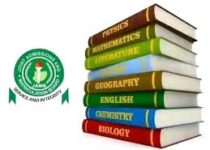WAEC Syllabus For Animal Husbandry 2026/2027 (ALT A) & Textbooks
The WAEC Syllabus For Animal Husbandry 2026/2027covers topics like Animal production, management, processing, marketing, and entrepreneurship, Animal anatomy and nutrition to disease control and pasture management.
Contents
The Aims & Objectives
- Basic animal production practices such as feeding, housing, pest and disease control
- The efficient and effective management of animal enterprises
- The application of environmentally friendly practices to sustain production
- The identification of basic problems hindering the improvement of the Animal Industry
- The efficient processing, preservation, packaging, storage and marketing of animals and their products.
The Scheme of Animal Husbandry
There will be three papers, Papers 1, 2 and 3, all of which must be taken. Papers 1 and 2 will be a composite paper to be taken at one sitting.
PAPER 1:
Will consist of fifty multiple choice objective questions all of which must be
answered within 1 hour for 50 marks.
PAPER 2:
Will consist of six essay-type questions. Candidates will be required to
answer four questions within 2 hours for 80 marks.
PAPER 3:
Will be a practical paper for school candidates or a test of practical paper for
private candidates. The paper will consist of four questions, all of which must
be answered within 2 hours for 60 marks.
DOWNLOAD HERE
WAEC Syllabus For Animal Husbandry 2026/2027
The topics related to Anatomy, Physiology, Production, and Health of Farm Animals are divided into distinct and logical categories.
| Major Topics | Sub-Topics and Concepts |
| I. Anatomy and Physiology of Farm Animals | Meaning of Terms: Anatomy, physiology, and external orientation of farm animals. |
| Digestive System: Comparative anatomy of the digestive system of farm animals. Digestion and absorption processes in various classes of farm animals. | |
| Nervous System: Parts of the Central Nervous System (CNS) and Autonomic Nervous System (ANS). Functions of the ANS. | |
| Endocrine System: Endocrine glands and their functions. Hormones and their functions. | |
| Other Systems: Integumentary, skeletal, and muscular systems. | |
| Reproductive System: Anatomy of the reproductive system of poultry and livestock. Functions of organs and parts. Reproductive processes. | |
| Circulatory System: Structure and functions. Heart and pulse rate. | |
| Respiratory System: Meaning and importance of respiration. Structure and functions of the respiratory system. | |
| Excretory System: Meaning and importance of excretion. Structure and functions of the excretory system. Excretory products. | |
| II. Animal Nutrition | Introduction: Meaning and importance of animal nutrition. Modes of feeding. |
| Feedstuffs and Supplements: Types, composition, and functions of feed nutrients. Classification of feedstuffs. Food tests. Producers and suppliers of feedstuffs and supplements. | |
| Feed Formulation and Preparation: Common terms used in feed formulation. Factors considered and steps in the formulation of ration. | |
| Handling and Storage: Importance of feed storage and features of storage structures. Factors that affect the quality of stored feed. Record keeping and estimation of cost. Pests of stored feed and their control. | |
| III. Animal Health | Introduction: Meaning of terms. Signs of good and ill-health. Factors that predispose animals to diseases. |
| Diseases and Pathogens: Effects of diseases, pests, and parasites on animal production. Zoonotic diseases (importance and prevention). Classification and economic importance of pathogens. | |
| Disease Prevention and Control: Principles for prevention and control. Management practices in prevention and control. | |
| Parasites (Ecto- and Endoparasites): Types and examples of parasites. Structure, life cycle, and mode of feeding. Conditions that influence parasite population. Prevention and control. Economic importance of parasites. | |
| IV. Genetics and Animal Improvement | Genetic Principles: Heredity, basic genetic terms, and Mendel’s first law of inheritance. |
| Animal Improvement: Meaning, objectives, and benefits. Performance traits of improved and unimproved animals. Methods (advantages and disadvantages). Nutritional and environmental factors affecting improvement. | |
| Artificial Insemination (A.I.): Meaning and process of A.I. Advantages of A.I. Signs of heat (oestrus) and handling procedures in the collection and storage of semen. | |
| V. Environmental Physiology | Environment and Homeostasis: Internal and external environment of animals. Role of the nervous and endocrine systems in homeostasis and response to stimuli. |
| Measurements and Effects: Determination of room temperature, body temperature, and respiration rate. Effects of climate on farm animals. | |
| Stress Management: Modification of animal environment and management practices to reduce stress on animals. | |
| VI. Monogastric and Domestic Pet Production | Poultry Production: Definition, characteristics, classes, breeds, and types. Importance/role. Systems of production. |
| Incubation and Hatchery: Terminologies. Natural and Artificial Incubation. Selection of eggs. Conditions necessary for hatching. Incubation process. Candling of eggs. Marketing of day-old chicks. | |
| Poultry Management: Management Practices. Processing and marketing. Prospects of producing various types of poultry. | |
| Pig Production: Types, breeds, and characteristics. Importance. Systems of keeping pigs. Management practices. Slaughtering, processing, and marketing. | |
| Domestic Pets: Meaning and importance of pets. Management of pets. Training and marketing of pets. | |
| VII. Ruminant Production | Sheep and Goat Production: Common breeds, distribution, and characteristics. Importance. Management practices. Common parasites and diseases and their control. Processing and marketing. |
| Beef Cattle Production: Breeds and characteristics. Importance. Common production systems. Planning, production, and management for beef and traction. General management practices. Processing and marketing. Major problems in beef cattle production. | |
| Dairy Cattle Production: Breeds and features. Characteristics, sources, and importance of milk. Management practices. Diseases and their control. Production, processing, and marketing of milk and dairy products. Problems of dairy cattle production in warm climates. | |
| VIII. Range and Pasture Management | Introduction: Basic terminologies. Types of pasture and their features. Importance of pastures and forage crops. Factors that affect pasture productivity. Major forage crops. Poisonous plants. |
| Pasture Establishment and Management: Qualities of good pasture and forage species. Establishment of pasture. Improving natural pastures. Management of cultivated pastures. Harvesting of forage crops. | |
| Forage Conservation: Meaning and importance of forage conservation. Preparation of hay and silage. Utilization of crop residue in feeding animals. | |
| IX. Non-Traditional Animal Production | Rabbit and Grasscutter Production: Common breeds. Importance. Management Practices. Processing and Marketing. |
| Snail Farming (Heliculture): Meaning and importance. External features of snails. Types of species. Site selection. Management Practices. Processing and marketing of snails. | |
| X. Integrated Practical Application | Establishing Enterprises: Breeds of farm animals, classification, anatomy and physiology, animal nutrition, diseases/prevention, artificial insemination, environmental physiology, management practices, animal products/by-products, range/pasture management, animal housing and structures. |
- TRENDING BLOG POST
- Waec Syllabus For Agricultural Science 2026/2027- PDF Download
- WAEC Syllabus For Mathematics 2026/2027 PDF Download
- WAEC Timetable 2026/2027 for Art Students PDF Download
- WAEC Portal Login 2026/2027
- How To Answer WAEC Questions Correctly In 2026/2027
List of Facilities and Major Equipments
A. FARM BUILDING/STRUCTURE
| ITEM NO | EQUIPMENT | QUANTITY REQUIRED |
| 1 | Poultry/Pig House/Battery Cages | 1 |
| 2 | Cattle/Goat/Sheep Pen | 1 |
| 3 | Rabbit/Grass cutter Hutch | 1 |
| 4 | Snairy/Bee Hive | 1 |
B. LIVE ANIMALS
| ITEM NO. | EQUIPMENT | QUANTITY REQUIRED |
| 1. | Poultry/Pig | 10 |
| 2. | Rabbits/Grass cutter | 10 |
| 3. | Cattle/Sheep/Goat | 10 |
| 4. | Snails/Bees | 50/100 |
C. SPECIMEN
| ITEM NO. | EQUIPMENT |
| 1. | Tick |
| 2. | Lice |
| 3. | Liver fluke |
| 4. | Tapeworm |
| 5. | Roundworm |
| 6. | Flea |
| 7. | Tsetse fly |
| 8. | Pests |
D. CHARTS AND PICTURES
| ITEM NO. | EQUIPMENT | QUANTITY REQUIRED |
| 1. | Digestive system of ruminants | 5 |
| 2. | Digestive system of non-ruminants | 5 |
| 3. | Reproductive organs of male livestock | 5 |
| 4. | Reproductive organs of female livestock | 5 |
| 5. | Reproductive tract of poultry | 5 |
| 6. | Skeletal system of farm animals | 5 |
| 7. | Circulatory system | 5 |
| 8. | Muscular system | 5 |
| 9. | Endocrine system | 5 |
| 10. | Calendar of ovulation | 5 |
| 11. | Calendar of Oestrus cycle | 5 |
| 12. | Classes of farm animals | 5 |
| 13. | Calendar of heat period | 5 |
| 14. | Calendar of animal diseases | 5 |
E. MACHINES AND EQUIPMENT
| ITEM NO. | EQUIPMENT | QUANTITY REQUIRED |
| 1. | Buddizor pliers/castrators | 2 |
| 2. | Elastrators | 2 |
| 3. | Debeakers | 2 |
| 4. | Candlers | 2 |
| 5. | Dehorning saw | 4 |
| 6. | Ear notching knife | 2 |
| 7. | Electro-ejaculator | 2 |
| 8. | Artificial Inseminators | 2 |
| 9. | Hand sprayer/Knapsack sprayer | 2 |
| 10. | Refrigerators to store materials | 2 |
| 11. | Clinical thermometer | 2 |
| 12. | Films | Many |
| 13. | Television | 2 |
| 14. | CD Video Player | 2 |
| 15. | 16mm Film Projector | 2 |
F. DRUGS/VACCINES/MATERIALS
| ITEM NO. | EQUIPMENT | QUANTITY REQUIRED |
| 1. | First aids kits/boxes containing surgical blades, cotton wool, iodine and razor. | 2 |
| 2. | Sterilizers e.g. Dettol, Izal | 4 |
| 3. | Syringes and Needles | 10 |
| 4. | Vaccines (various forms) | 5 |
| 5. | Formalin, etc. | 2 bottles |
G. FEED SAMPLES
| ITEM NO. | EQUIPMENT | QUANTITY REQUIRED |
| 1. | Bone meal | ½ kg |
| 2. | Blood meal | ½ kg |
| 3. | Fish meal | ½ kg |
| 4. | Groundnut cake | ½ kg |
| 5. | Maize grains | ½ kg |
| 6. | Groundnut meal | ½ kg |
| 7. | Coconut meal | ½ kg |
| 8. | Egg shell meal | ½ kg |
| 9. | Palm kernel meal | ½ kg |
| 10. | Periwinkle shell | ½ kg |
| 11. | Mineral salt lick, etc. | ½ kg |
H. OTHER MATERIALS
| ITEM NO. | EQUIPMENT | QUANTITY REQUIRED |
| 1. | Feeding trough (Metal and Plastic) | 5 |
| 2. | Drinkers (Metal and Plastic) | 5 |
| 3. | Lanterns (source of heat) | 5 |
| 4. | Foot dips | 5 |
| 5. | Notebooks for Accounts and Records | 5 |
| 6. | Wheelbarrow | 5 |


